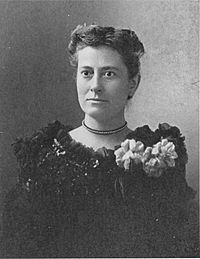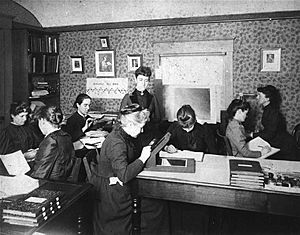Williamina Fleming facts for kids
Quick facts for kids
Williamina Fleming
|
|
|---|---|

Fleming, c. 1890s
|
|
| Born |
Williamina Paton Stevens
15 May 1857 Dundee, Scotland
|
| Died | 21 May 1911 (aged 54) Boston, Massachusetts, United States
|
| Nationality | British |
| Alma mater | None |
| Scientific career | |
| Fields | Astronomy |
| Signature | |
Williamina Paton Stevens Fleming (born May 15, 1857 – died May 21, 1911) was an amazing Scottish-American astronomer. She was a single mother who worked at the Harvard College Observatory. She helped create a system to name and classify stars.
Fleming cataloged over 10,000 stars! She also found 59 gas clouds called nebulae, more than 310 variable stars (stars that change brightness), and 10 novae (newly bright stars). One of her most famous discoveries was the Horsehead Nebula in 1888. Her work greatly helped advance the field of astronomy.
Contents
Early Life in Scotland
Williamina Paton Stevens was born in Dundee, Scotland, on May 15, 1857. Her parents were Mary Walker and Robert Stevens. Robert worked as a carver and gilder.
When she was just 14, Williamina started working as a pupil-teacher. In 1877, she married James Orr Fleming. He was an accountant from Dundee. They had one son named Edward P. Fleming.
A New Start in America
In 1878, Williamina and James moved to Boston, Massachusetts, in the United States. She was 21 years old at the time. Sadly, her husband left her and their young son.
Williamina then found work as a maid. She worked in the home of Professor Edward Charles Pickering. He was the director of the Harvard College Observatory (HCO). Professor Pickering's wife, Elizabeth, noticed Williamina's intelligence. She told her husband that Williamina had many talents.
In 1879, Professor Pickering hired Williamina. She started doing part-time office work at the observatory.
Joining the Harvard Computers
By 1881, Pickering invited Fleming to join the HCO full-time. He taught her how to study and analyze the light from stars, called stellar spectra. She became one of the first members of the Harvard Computers. This was a group of women hired by Pickering. Their job was to do complex math and help with the observatory's publications.

The Henry Draper Catalogue Project
In 1886, a wealthy widow named Mary Anna Draper started the Henry Draper Memorial. She gave money to the Harvard College Observatory for research. Because of this, the HCO began a huge project. They wanted to collect and classify the light spectra of as many stars as possible. This project was called the first Henry Draper Catalogue.
Williamina Fleming was put in charge of this important project. At first, another person, Nettie Farrar, started the analysis. But she left a few months later. Then, Antonia Maury suggested a very complicated way to classify the stars. However, Fleming wanted a much simpler and clearer method.
The observatory was using new photographic plates. These plates could capture the light from stars, even in the ultraviolet range. This made it possible to classify stars much more accurately. Fleming created a system to classify stars based on how much hydrogen was in their light. This was known as the Pickering-Fleming system. Stars with the most hydrogen were classified as 'A'. Those with the second most hydrogen were 'B', and so on.
Later, her colleague Annie Jump Cannon improved this system. She reordered the classifications based on the surface temperature of stars. This new system is called the Harvard spectral classification. It is still used by astronomers today!
In 1890, the HCO published the first Henry Draper Catalogue. This catalog was the result of years of hard work by the women computers. It had over 10,000 stars classified by their light spectrum. Williamina Fleming did most of these classifications herself. She also organized thousands of photographic plates. This made it easy to compare old and new images of the sky.
In 1898, Fleming was given a special job. She became the Curator of Astronomical Photographs at Harvard. She was the first woman to hold such a position!
At the 1893 World's Fair in Chicago, Fleming gave a speech. It was called "A Field for Woman's Work in Astronomy." In her speech, she encouraged more women to work in science. She believed that if women were given more chances, they could achieve great things.
Amazing Discoveries
During her career, Williamina Fleming made many important discoveries. She found a total of 59 gas clouds called nebulae. She also discovered over 310 variable stars and 10 novae.

Her most famous discovery happened in 1888. Fleming found the Horsehead Nebula on a photographic plate. This plate was made by astronomer W. H. Pickering, who was Professor E.C. Pickering's brother. She described the bright nebula (now known as IC 434) as having a "semicircular indentation."
Sadly, early publications did not always give Fleming credit for her discovery. The first Dreyer Index Catalogue did not even mention her name. It just said "Pickering" discovered the objects from Harvard. However, by 1908, when the second Dreyer Index Catalogue was published, Fleming and her female colleagues were well-known. They finally received proper credit for their amazing discoveries.
Fleming is also known for finding the first white dwarf star. White dwarfs are very dense, small stars.
In 1907, she published A Photographic Study of Variable Stars. This book listed 222 variable stars she had found. In 1911, she published Spectra and Photographic Magnitudes of Stars in Standard Regions.
Williamina Fleming became a U.S. citizen in 1907. She passed away from pneumonia in Boston on May 21, 1911.
Honors and Recognition
Williamina Fleming received many honors for her work:
- She was a member of the Astronomical and Astrophysical Society of America.
- She was also a member of the Astronomical Society of France.
- In 1906, she became an honorary member of the Royal Astronomical Society of London. She was the first American woman to be chosen for this honor.
- She received the Guadalupe Almendaro Medal from the Astronomical Society of Mexico. This was for her discovery of new stars.
- She was an honorary fellow in astronomy at Wellesley College.
Lasting Legacy
Williamina Fleming's contributions to astronomy are still remembered today:
- A lunar crater on the Moon, called Fleming, is named after her. It is also partly named after Alexander Fleming.
- An asteroid, 5747 Williamina, is named in her honor.
The women of the Harvard Computers were famous during their lives. But for a long time, they were mostly forgotten. In 2015, Lindsay Smith Zrull, a curator at Harvard, found many notebooks from these women. She realized these important records needed to be saved.
Because of this, the Wolbach Library started Project PHaEDRA. This project aims to save and make available Harvard's early astronomy data. Daina Bouquin, the head librarian, explained that the goal is to make their work easy to find. If you search for Williamina Fleming, you will find her actual work, not just mentions of her.
In July 2017, the Wolbach Library at the Center for Astrophysics | Harvard & Smithsonian showed a special display. It featured Fleming's work, including the log book where she first wrote about the Horsehead Nebula. The library has many volumes of Fleming's work in its PHaEDRA collection.
As of August 2017, about 200 of over 2,500 volumes had been typed up. This huge task is expected to take many years to finish. Some of the notebooks are available online for volunteers to help transcribe them.
Images for kids
See also
 In Spanish: Williamina Fleming para niños
In Spanish: Williamina Fleming para niños

